Charles E W Bean, Diaries, AWM38 3DRL 606/228/1 - Folder - Part 10
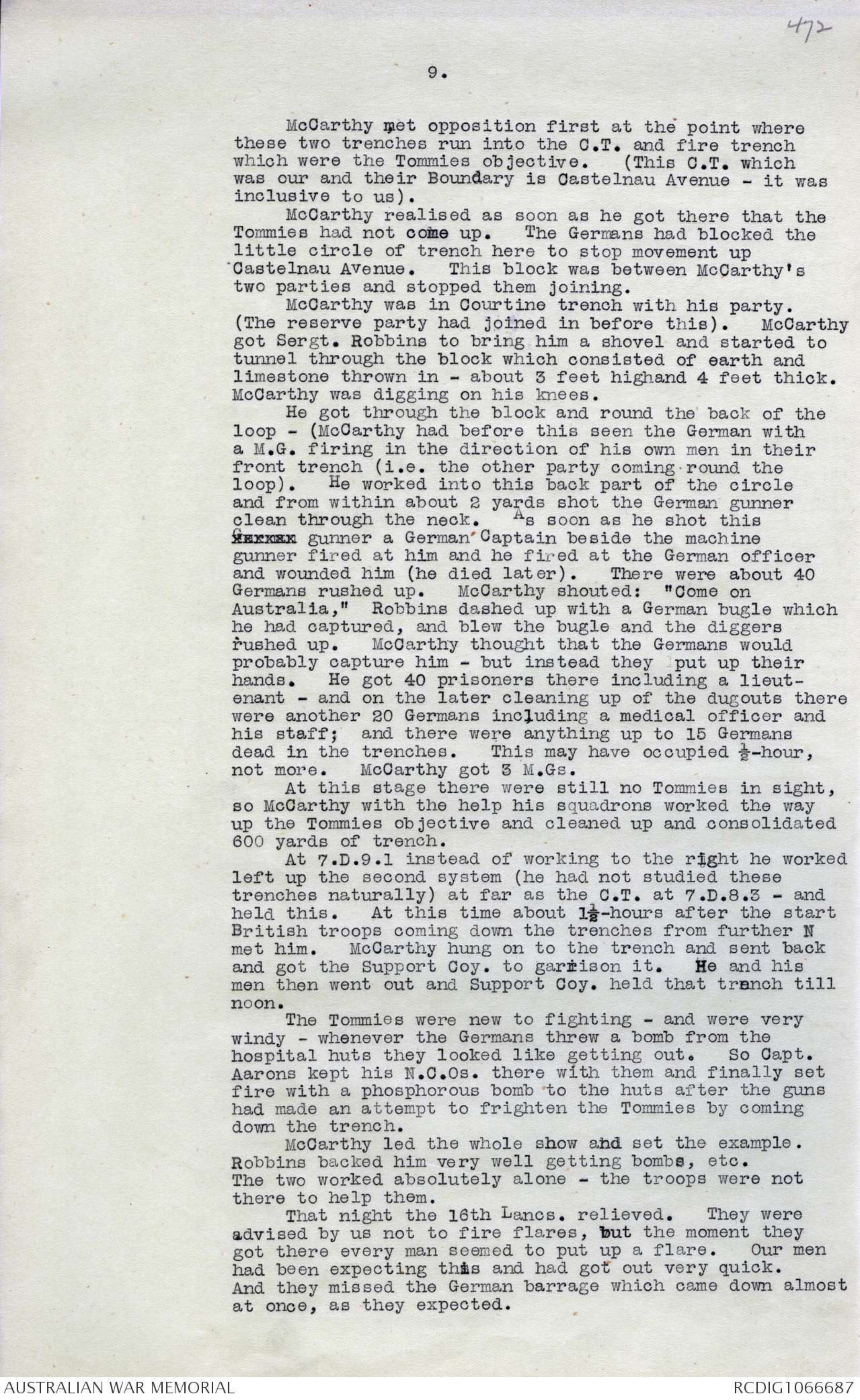
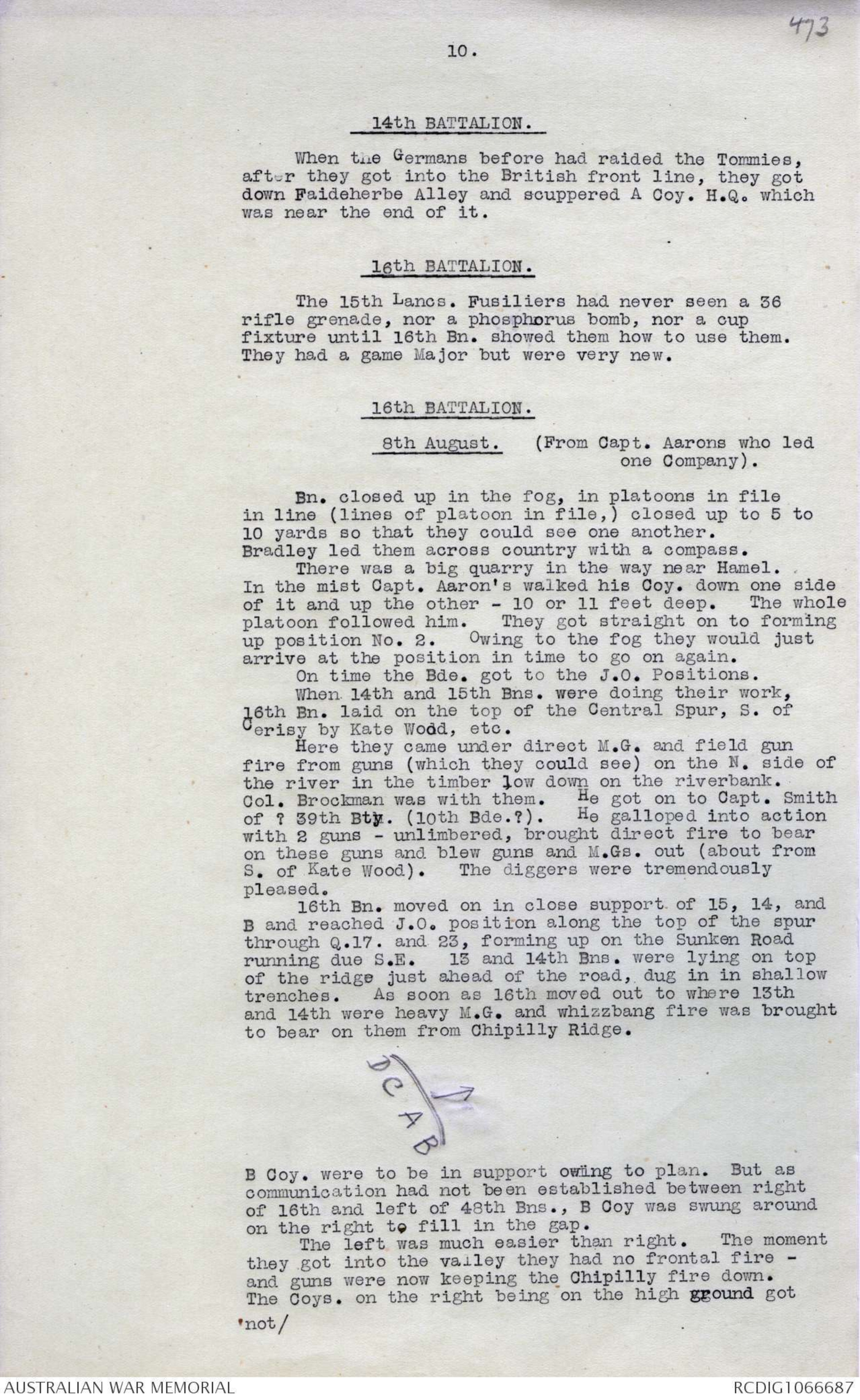
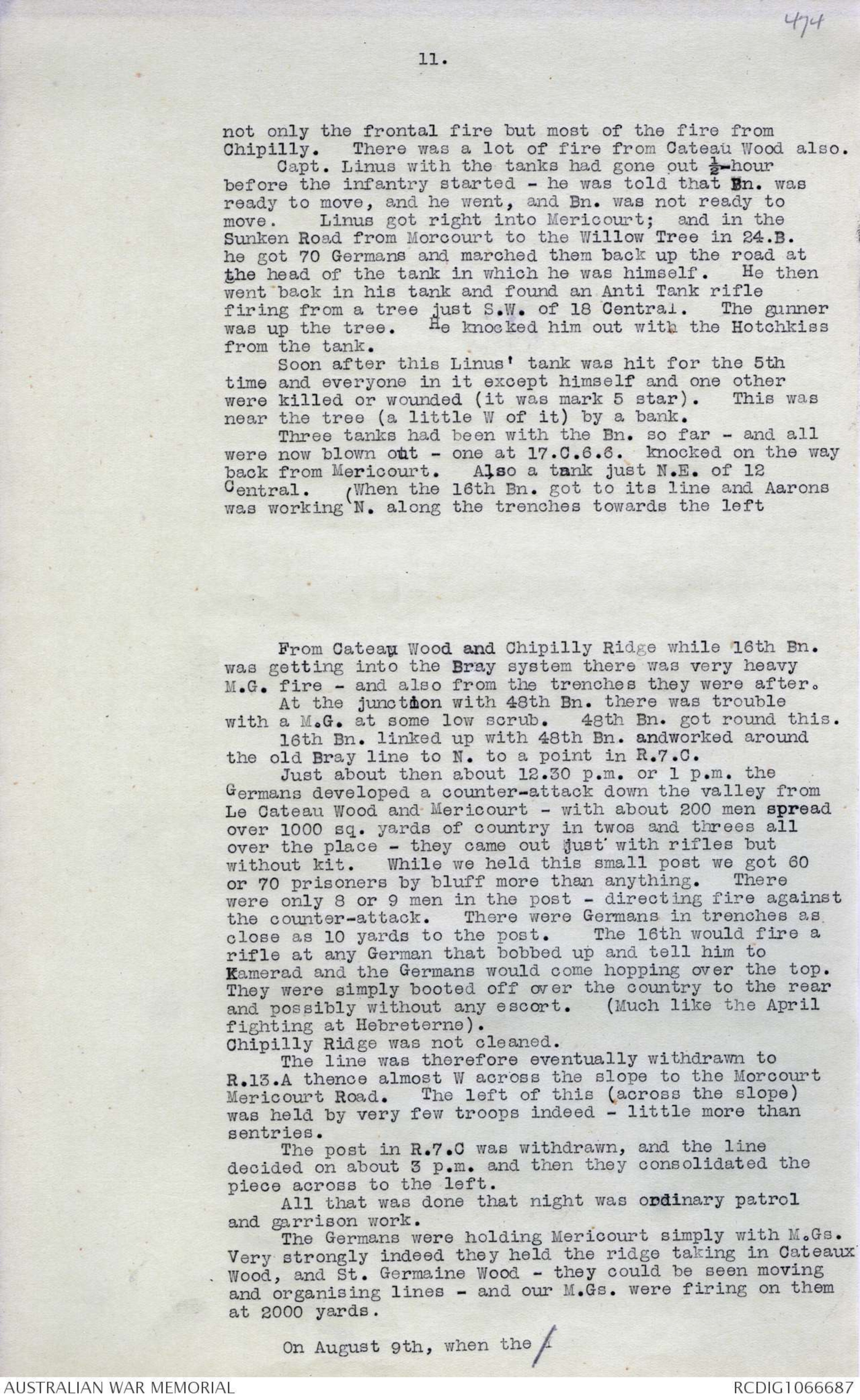
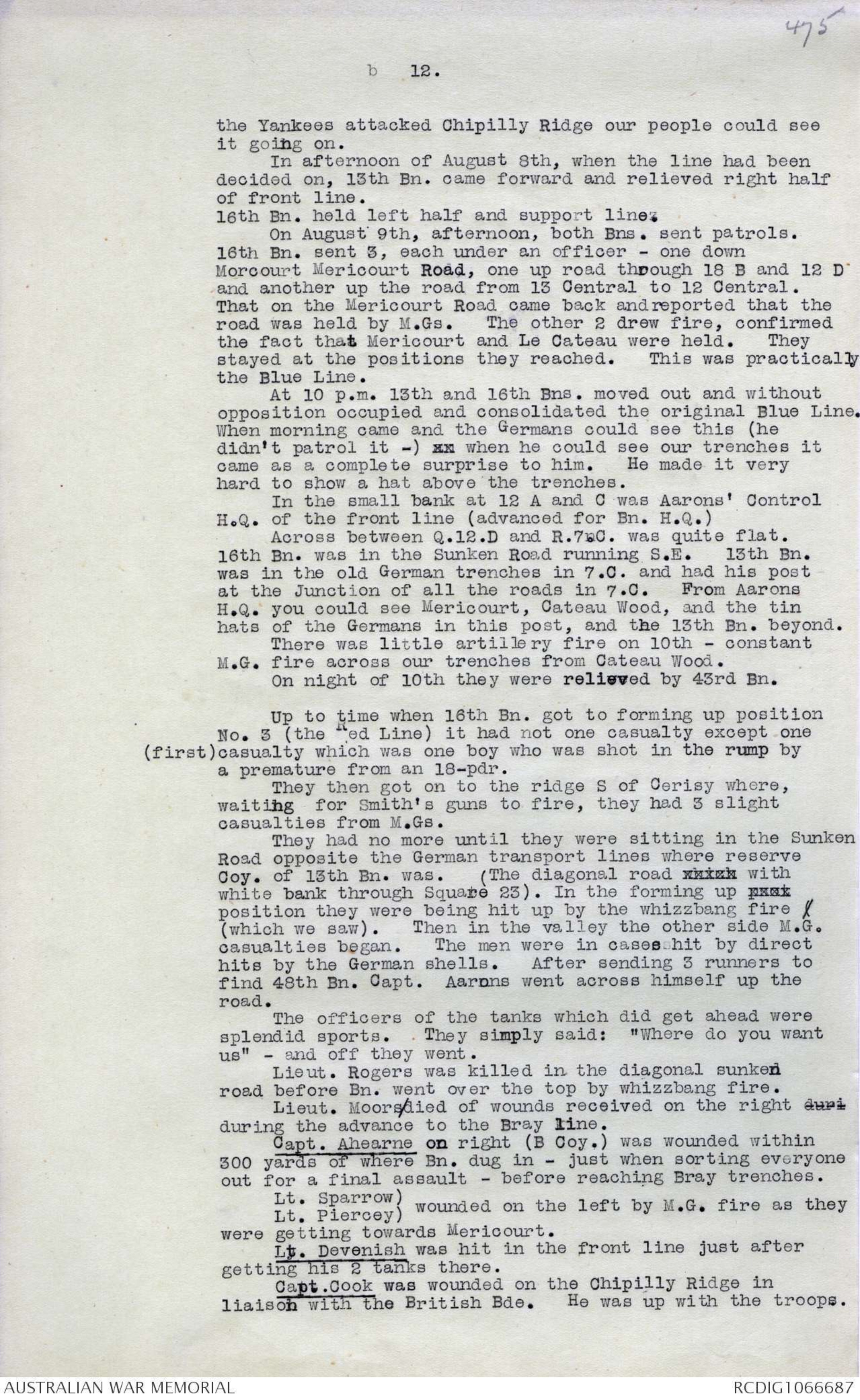
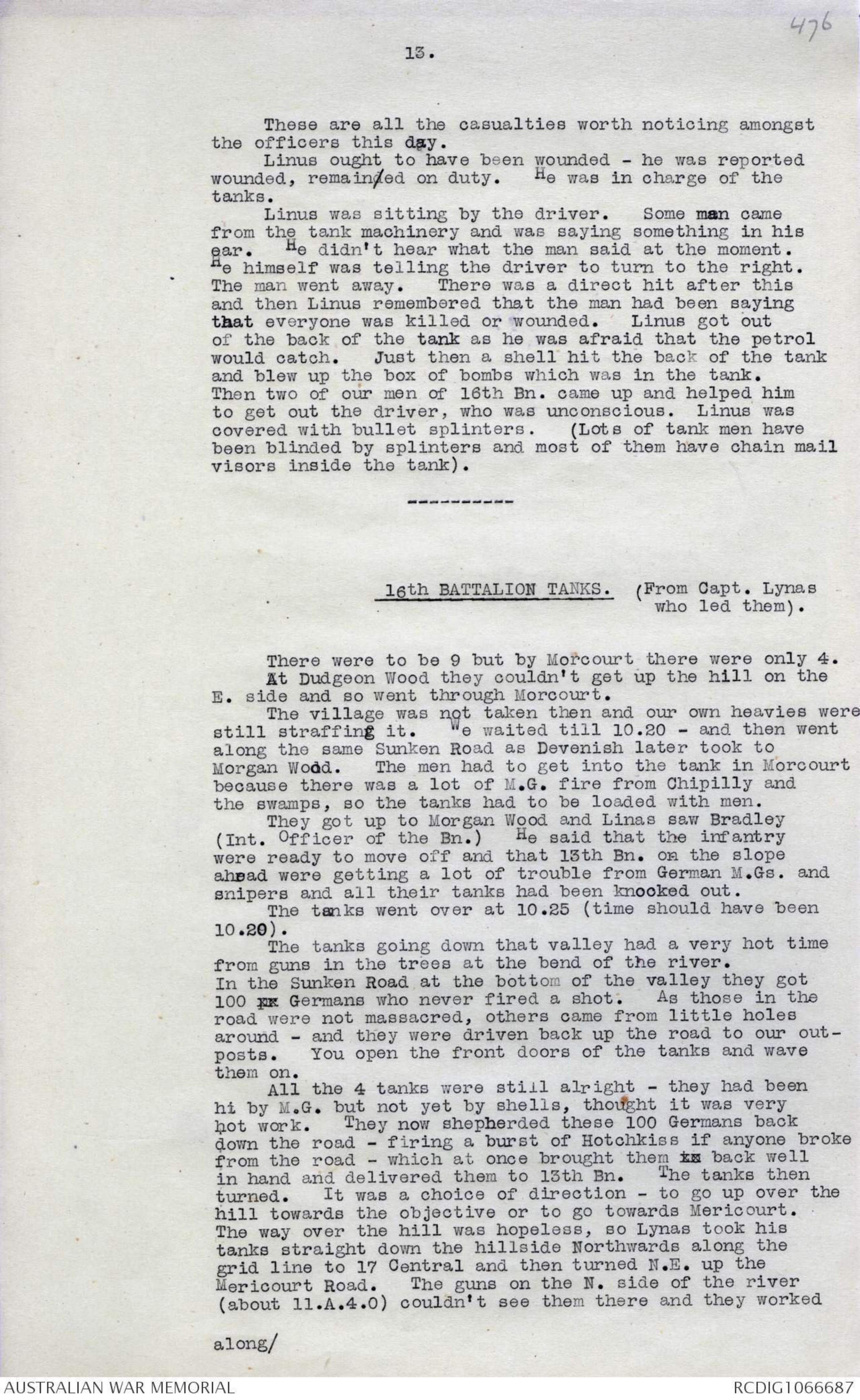
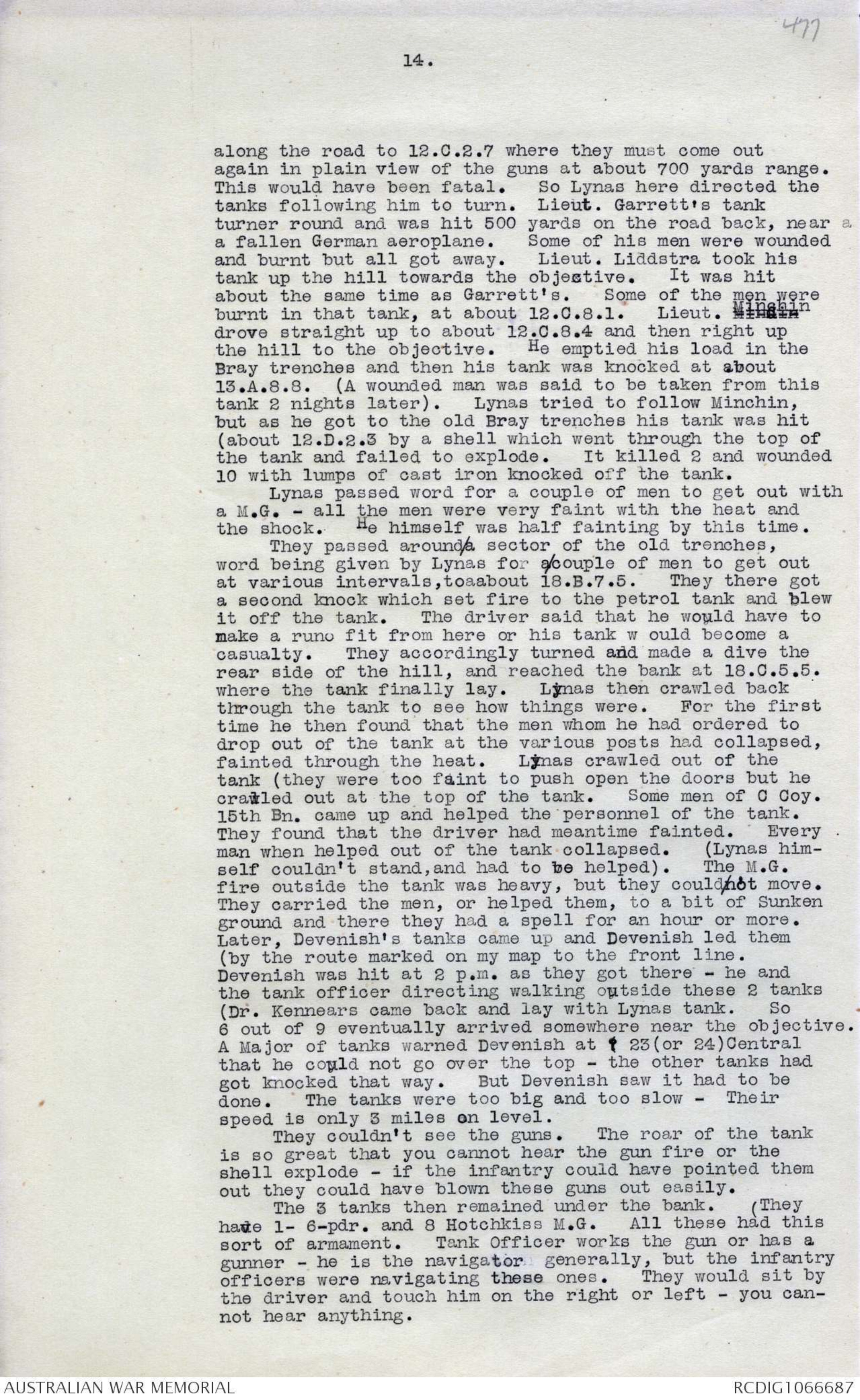
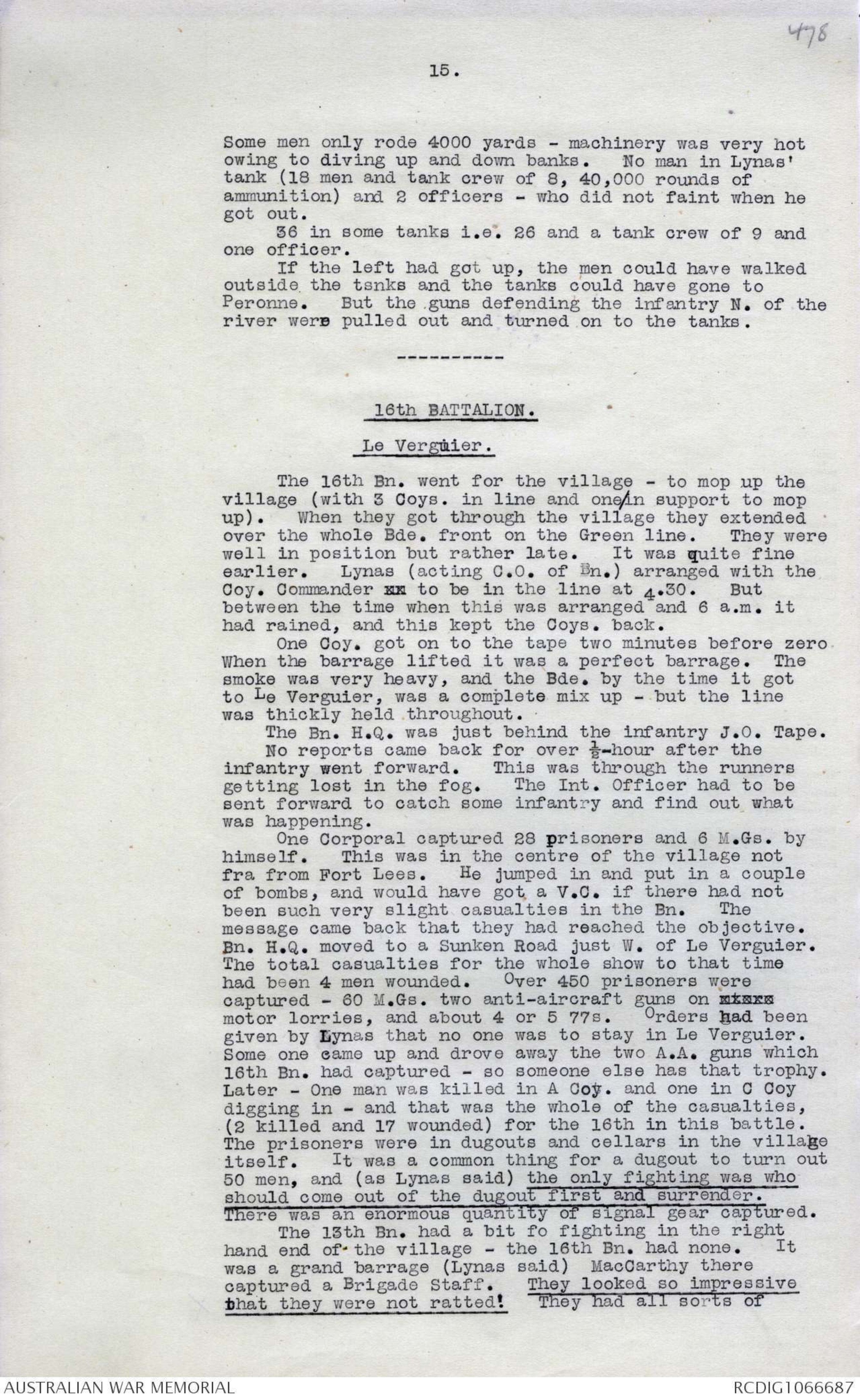
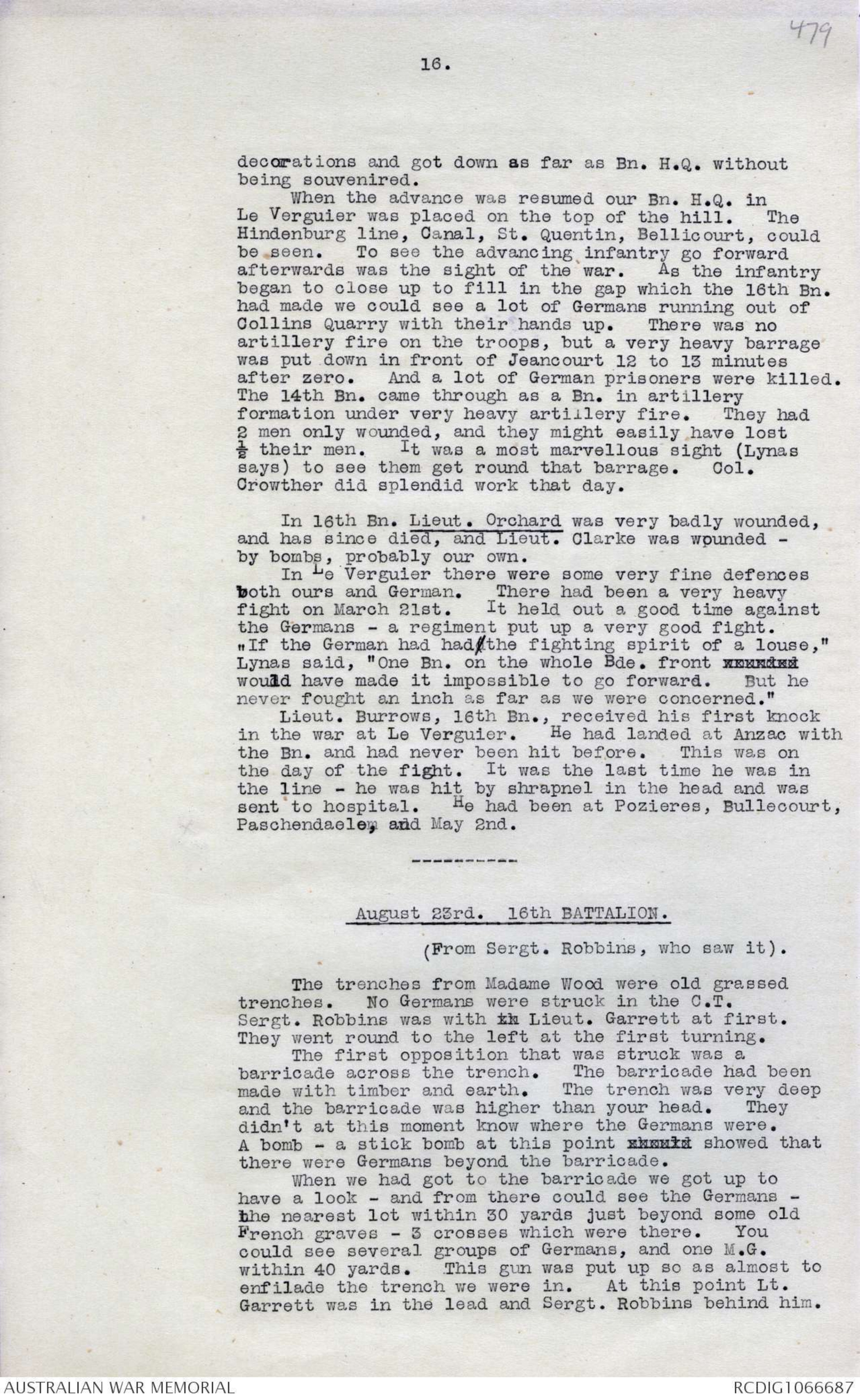
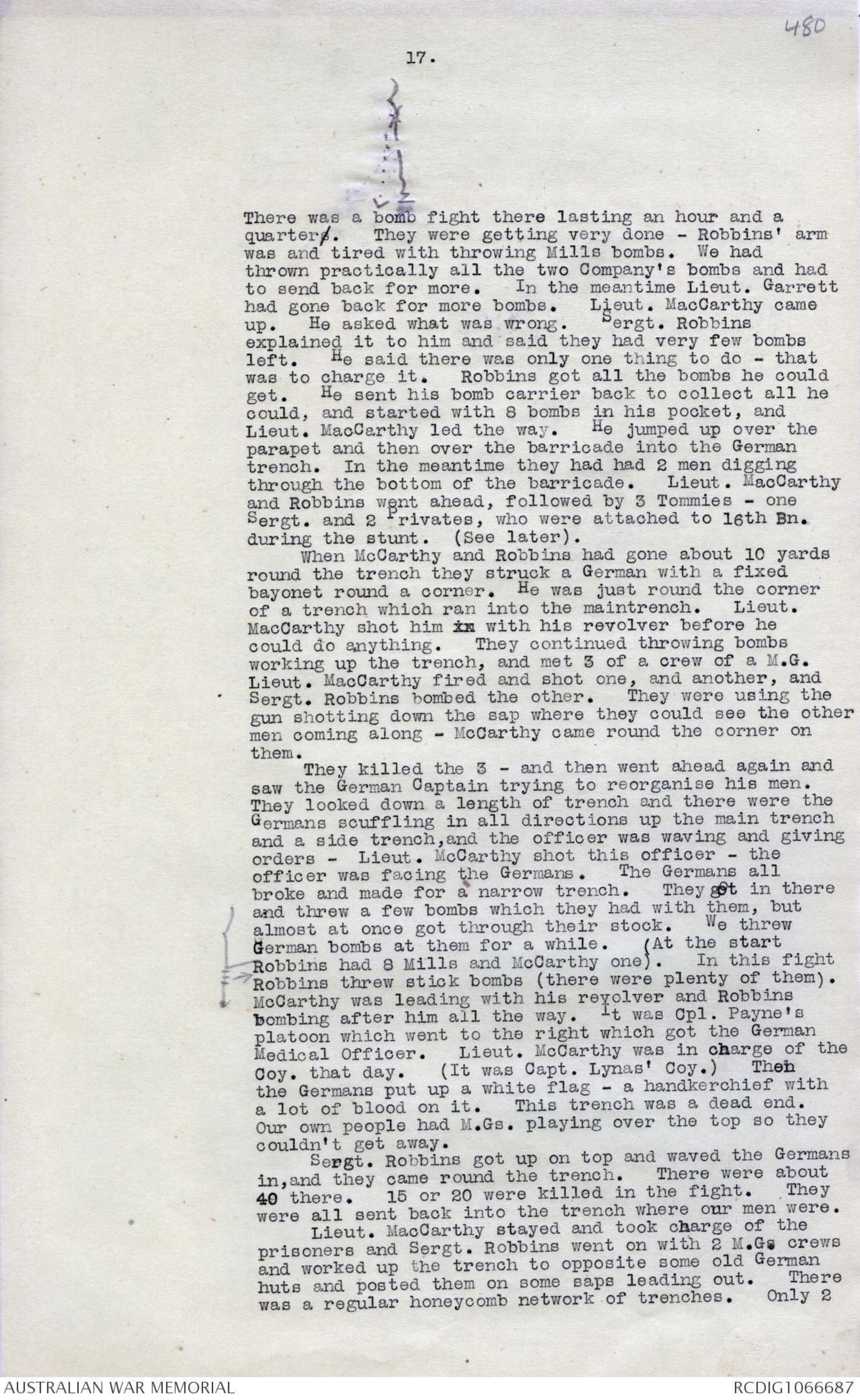
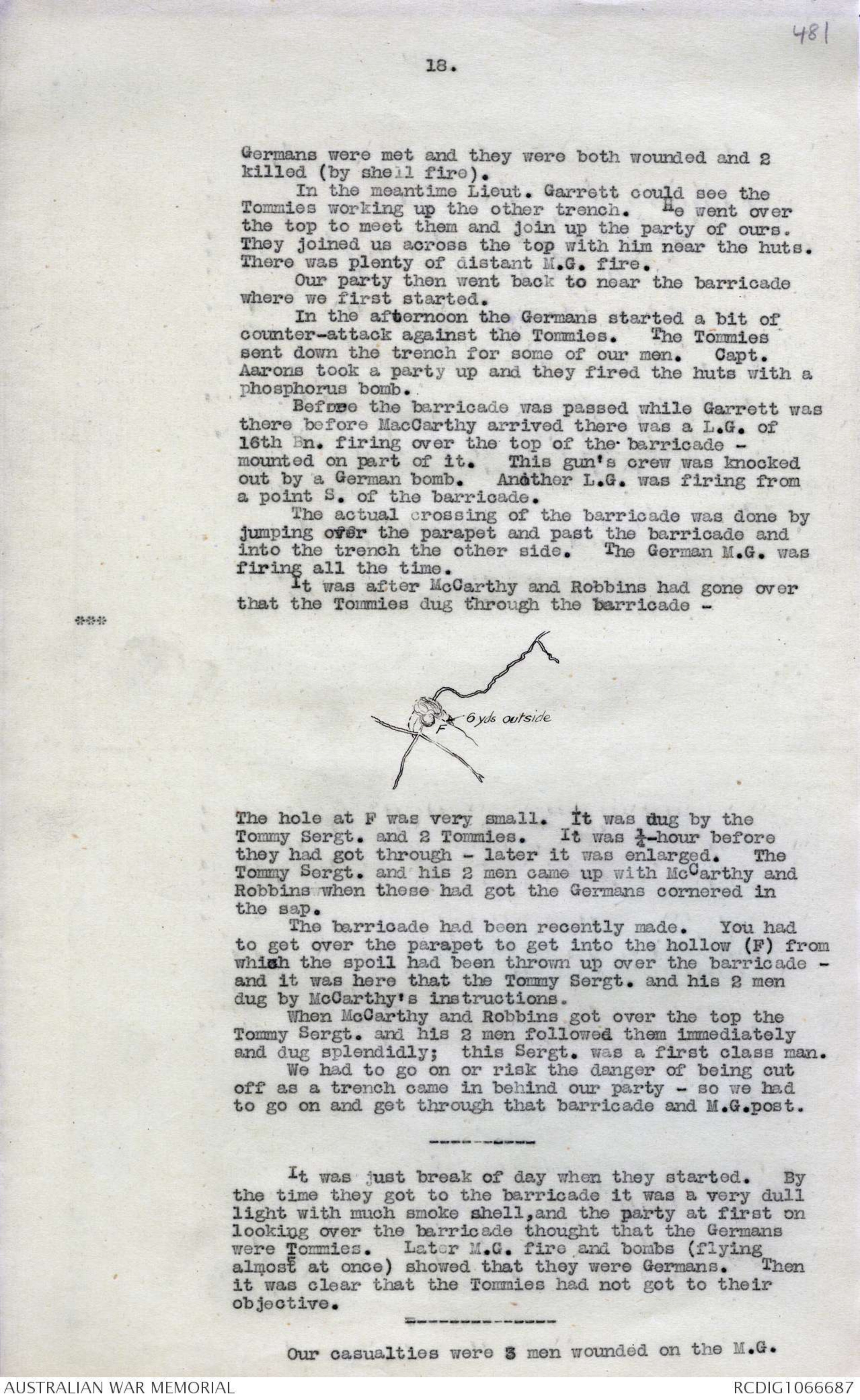
472
9.
McCarthy met opposition first at the point where
these two trenches run into the C.T. and fire trench
which were the Tommies objective. (This C.T. which
was our and their Boundary is Castelnau Avenue - it was
inclusive to us).
McCarthy realised as soon as he got there that the
Tommies had not come up. The Germans had blocked the
little circle of trench here to stop movement up
Castelnau Avenue. This block was between McCarthy's
two parties and stopped them joining.
McCarthy was in Courtine trench with his party.
(The reserve party had joined in before this). McCarthy
got Sergt. Robbins to bring him a shovel and started to
tunnel through the block which consisted of earth and
limestone thrown in - about 3 feet highand 4 feet thick.
McCarthy was digging on his knees.
He got through the block and round the back of the
loop - (McCarthy had before this seen the German with
a M.G. firing in the direction of his own men in their
front trench (i.e. the other party coming round the
loop). He worked into this back part of the circle
and from within about 2 yards shot the German gunner
clean through the neck. As soon as he shot thisxxxxxx gunner a German Captain beside the machine
gunner fired at him and he fired at the German officer
and wounded him (he died later). There were about 40
Germans rushed up. McCarthy shouted: "Come on
Australia," Robbins dashed up with a German bugle which
he had captured, and blew the bugle and the diggers
rushed up. McCarthy thought that the Germans would
probably capture him - but instead they put up their
hands. He got 40 prisoners there including a lieutenant
- and on the later cleaning up of the dugouts there
were another 20 Germans including a medical officer and
his staff; and there were anything up to 15 Germans
dead in the trenches. This may have occupied ½-hour,
not more. McCarthy got 3 M.Gs.
At this stage there were still no Tommies in sight,
so McCarthy with the help his squadrons worked the way
up the Tommies objective and cleaned up and consolidated
600 yards of trench.
At 7.D.9.1 instead of working to the right he worked
left up the second system (he had not studied these
trenches naturally) at far as the C.T. at 7.D.8.3 - and
held this. At this time about 1½-hours after the start
British troops coming down the trenches from further N
met him. McCarthy hung on to the trench and sent back
and got the Support Coy. to garrison it. He and his
men then went out and Support Coy. held that trench till
noon.
The Tommies were new to fighting - and were very
windy - whenever the Germans threw a bomb from the
hospital huts they looked like getting out. So Capt.
Aarons kept his N.C.Os. there with them and finally set
fire with a phosphorous bomb to the huts after the guns
had made an attempt to frighten the Tommies by coming
down the trench.
McCarthy led the whole show and set the example.
Robbins backed him very well getting bombs, etc.
The two worked absolutely alone - the troops were not
there to help them.
That night the 16th Lancs. relieved. They were
advised by us not to fire flares, but the moment they
got there every man seemed to put up a flare. Our men
had been expecting this and had got out very quick.
And they missed the German barrage which came down almost
at once, as they expected.
473
10.
14th BATTALION.
When the Germans before had raided the Tommies,
after they got into the British front line, they got
down Faideherbe Alley and scuppered A Coy. H.Q. which
was near the end of it.
16th BATTALION.
The 15th Lancs. Fusiliers had never seen a 36
rifle grenade, nor a phosphorus bomb, nor a cup
fixture until 16th Bn. showed them how to use them.
They had a game Major but were very new.
16th BATTALION.
8th August. (From Capt. Aarons who led
one Company).
Bn. closed up in the fog, in platoons in file
in line (lines of platoon in file,) closed up to 5 to
10 yards so that they could see one another.
Bradley led them across country with a compass.
There was a big quarry in the way near Hamel.
In the mist Capt. Aaron's walked his Coy. down one side
of it and up the other - 10 or 11 feet deep. The whole
platoon followed him. They got straight on to forming
up position No. 2. Owing to the fog they would just
arrive at the position in time to go on again.
On time the Bde. got to the J.0. Positions.
When 14th and 15th Bns. were doing their work,
16th Bn. laid on the top of the Central Spur, S. of
Cerisy by Kate Wood, etc.
Here they came under direct M.G. and field gun
fire from guns (which they could see) on the N. side of
the river in the timber low down on the riverbank.
Col. Brockman was with them. He got on to Capt. Smith
of ? 39th Bty. (10th Bde.?). He galloped into action
with 2 guns - unlimbered, brought direct fire to bear
on these guns and blew guns and M.Gs. out (about from
S. of Kate Wood). The diggers were tremendously
pleased.
16th Bn. moved on in close support of 15, 14, and
B and reached J.O. position along the top of the spur
through Q.17. and 23, forming up on the Sunken Road
running due S.E. 13 and 14th Bns. were lying on top
of the ridge just ahead of the road, dug in in shallow
trenches. As soon as 16th moved out to where 13th
and 14th were heavy M.G. and whizzbang fire was brought
to bear on them from Chipilly Ridge.
Diagram- see original document
B Coy. were to be in support owing to plan. But as
communication had not been established between right
of 16th and left of 48th Bns., B Coy was swung around
on the right to fill in the gap.
The left was much easier than right. The moment
they got into the valley they had no frontal fire -
and guns were now keeping the Chipilly fire down.
The Coys. on the right being on the high ground got
'not/
474
11.
not only the frontal fire but most of the fire from
Chipilly. There was a lot of fire from Cateau Wood also.
Capt. Linus with the tanks had gone out ½-hour
before the infantry started - he was told that Bn. was
ready to move, and he went, and Bn. was not ready to
move. Linus got right into Mericourt; and in the
Sunken Road from Morcourt to the Willow Tree in 24.B.
he got 70 Germans and marched them back up the road at
the head of the tank in which he was himself. He then
went back in his tank and found an Anti Tank rifle
firing from a tree just S.W. of 18 Central. The gunner
was up the tree. He knocked him out with the Hotchkiss
from the tank.
Soon after this Linus' tank was hit for the 5th
time and everyone in it except himself and one other
were killed or wounded (it was mark 5 star). This was
near the tree (a little W of it) by a bank.
Three tanks had been with the Bn. so far - and all
were now blown out - one at 17.C.6.6. knocked on the way
back from Mericourt. Also a tank just N.E. of 12
Central. (When the 16th Bn. got to its line and Aarons
was working N. along the trenches towards the left
From Cateau Wood and Chipilly Ridge while 16th Bn.
was getting into the Bray system there was very heavy
M.G. fire - and also from the trenches they were after.
At the junction with 48th Bn. there was trouble
with a M.G. at some low scrub. 48th Bn. got round this.
16th Bn. linked up with 48th Bn. andworked around
the old Bray line to N. to a point in R.7.C.
Just about then about 12.30 p.m. or 1 p.m. the
Germans developed a counter-attack down the valley from
Le Cateau Wood and Mericourt - with about 200 men spread
over 1000 sq. yards of country in twos and threes all
over the place - they came out just with rifles but
without kit. While we held this small post we got 60
or 70 prisoners by bluff more than anything. There
were only 8 or 9 men in the post - directing fire against
the counter-attack. There were Germans in trenches as
close as 10 yards to the post. The 16th would fire a
rifle at any German that bobbed up and tell him to
Kamerad and the Germans would come hopping over the top.
They were simply booted off over the country to the rear
and possibly without any escort. (Much like the April
fighting at Hebreterne).
Chipilly Ridge was not cleaned.
The line was therefore eventually withdrawn to
R.13.A thence almost W across the slope to the Morcourt
Mericourt Road. The left of this (across the slope)
was held by very few troops indeed - little more than
sentries.
The post in R.7.C was withdrawn, and the line
decided on about 3 p.m. and then they consolidated the
piece across to the left.
All that was done that night was ordinary patrol
and garrison work.
The Germans were holding Mericourt simply with M.Gs.
Very strongly indeed they held the ridge taking in Cateaux
Wood, and St. Germaine Wood - they could be seen moving
and organising lines - and our M.Gs. were firing on them
at 2000 yards.
On August 9th, when the /
475
b 12.
the Yankees attacked Chipilly Ridge our people could see
it going on.
In afternoon of August 8th, when the line had been
decided on, 13th Bn. came forward and relieved right half
of front line.
16th Bn. held left half and support line.
On August 9th, afternoon, both Bns. sent patrols.
16th Bn. sent 3, each under an officer - one down
Morcourt Mericourt Road, one up road through 18 B and 12 D
and another up the road from 13 Central to 12 Central.
That on the Mericourt Road came back and reported that the
road was held by M.Gs. The other 2 drew fire, confirmed
the fact that Mericourt and Le Cateau were held. They
stayed at the positions they reached. This was practically
the Blue Line.
At 10 p.m. 13th and 16th Bns. moved out and without
opposition occupied and consolidated the original Blue Line.
When morning came and the Germans could see this (he
didn't patrol it -) xx when he could see our trenches it
came as a complete surprise to him. He made it very
hard to show a hat above the trenches.
In the small bank at 12 A and C was Aarons' Control
H.Q. of the front line (advanced for Bn. H.Q.)
Across between Q.12.D and R.7.C. was quite flat.
16th Bn. was in the Sunken Road running S.E. 13th Bn.
was in the old German trenches in 7.C. and had his post
at the Junction of all the roads in 7.C. From Aarons
H.Q. you could see Mericourt, Cateau Wood, and the tin
hats of the Germans in this post, and the 13th Bn. beyond.
There was little artillery fire on 10th - constant
M.G. fire across our trenches from Cateau Wood.
On night of 10th they were relieved by 43rd Bn.
Up to time when 16th Bn. got to forming up position
No.3 (the Red Line) it had not one casualty except one
(first) casualty which was one boy who was shot in the rump by
a premature from an 18-pdr.
They then got on to the ridge S of Cerisy where,
waiting for Smith's guns to fire, they had 3 slight
casualties from M.Gs.
They had no more until they were sitting in the Sunken
Road opposite the German transport lines where reserve
Coy. of 13th Bn. was. (The diagonal road xxxxx with
white bank through Square 23). In the forming up xxxx
position they were being hit up by the whizzbang fire
(which we saw). Then in the valley the other side M.G.
casualties began. The men were in cases hit by direct
hits by the German shells. After sending 3 runners to
find 48th Bn. Capt. Aarons went across himself up the
road.
The officers of the tanks which did get ahead were
splendid sports. They simply said: "Where do you want
us" - and off they went.
Lieut. Rogers was killed in the diagonal sunken
road before Bn. went over the top by whizzbang fire.
Lieut. Moors died of wounds received on the right duri
during the advance to the Bray line.
Capt. Ahearne on right (B Coy.) was wounded within
300 yards of where Bn. dug in - just when sorting everyone
out for a final assault - before reaching Bray trenches.
Lt. Sparrow)
Lt. Piercey) wounded on the left by M.G. fire as they
were getting towards Mericourt.
Lt. Devenish was hit in the front line just after
getting his 2 tanks there.
Capt.Cook was wounded on the Chipilly Ridge in
liaison with the British Bde. He was up with the troops.
476
13.
These are all the casualties worth noticing amongst
the officers this day.
Linus ought to have been wounded - he was reported
wounded, remainded on duty. He was in charge of the
tanks.
Linus was sitting by the driver. Some man came
from the tank machinery and was saying something in his
ear. He didn't hear what the man said at the moment.
He himself was telling the driver to turn to the right.
The man went away. There was a direct hit after this
and then Linus remembered that the man had been saying
that everyone was killed or wounded. Linus got out
of the back of the tank as he was afraid that the petrol
would catch. Just then a shell hit the back of the tank
and blew up the box of bombs which was in the tank.
Then two of our men of 16th Bn. came up and helped him
to get out the driver, who was unconscious. Linus was
covered with bullet splinters. (Lots of tank men have
been blinded by splinters and most of them have chain mail
visors inside the tank).
16th BATTALION TANKS. (From Capt. Lynas who led them).
There were to be 9 but by Morcourt there were only 4.
At Dudgeon Wood they couldn't get up the hill on the
E. side and so went through Morcourt.
The village was not taken then and our own heavies were
still straffing it. We waited till 10.20 - and then went
along the same Sunken Road as Devenish later took to
Morgan Wood. The men had to get into the tank in Morcourt
because there was a lot of M.G. fire from Chipilly and
the swamps, so the tanks had to be loaded with men.
They got up to Morgan Wood and Linas saw Bradley
(Int. Officer of the Bn.) He said that the infantry
were ready to move off and that 13th Bn. on the slope
ahead were getting a lot of trouble from German M.Gs. and
snipers and all their tanks had been knocked out.
The tanks went over at 10.25 (time should have been
10.20).
The tanks going down that valley had a very hot time
from guns in the trees at the bend of the river.
In the Sunken Road at the bottom of the valley they got
100 xx Germans who never fired a shot. As those in the
road were not massacred, others came from little holes
around - and they were driven back up the road to our out-
posts. You open the front doors of the tanks and wave
them on.
All the 4 tanks were still alright - they had been
hi by M.G. but not yet by shells, thought it was very
hot work. They now shepherded these 100 Germans back
down the road - firing a burst of Hotchkiss if anyone broke
from the road - which at once brought them xx back well
in hand and delivered them to 13th Bn. The tanks then
turned. It was a choice of direction - to go up over the
hill towards the objective or to go towards Mericourt.
The way over the hill was hopeless, so Lynas took his
tanks straight down the hillside Northwards along the
grid line to 17 Central and then turned N.E. up the
Mericourt Road. The guns on the N. side of the river
(about 11.A.4.0) couldn't see them there and they worked
along/
477
14.
along the road to 12.C.2.7 where they must come out
again in plain view of the guns at about 700 yards range.
This would have been fatal. So Lynas here directed the
tanks following him to turn. Lieut. Garrett's tank
turner round and was hit 500 yards on the road back, near
a fallen German aeroplane. Some of his men were wounded
and burnt but all got away. Lieut. Liddstra took his
tank up the hill towards the objective. It was hit
about the same time as Garrett's. Some of the men were
burnt in that tank, at about 12.C.8.1. Lieut. Mincin Minchin
drove straight up to about 12.C.8.4 and then right up
the hill to the objective. He emptied his load in the
Bray trenches and then his tank was knocked at about
13.A.8.8. (A wounded man was said to be taken from this
tank 2 nights later). Lynas tried to follow Minchin,
but as he got to the old Bray trenches his tank was hit
(about 12.D.2.3 by a shell which went through the top of
the tank and failed to explode. It killed 2 and wounded
10 with lumps of cast iron knocked off the tank.
Lynas passed word for a couple of men to get out with
a M.G. - all the men were very faint with the heat and
the shock. He himself was half fainting by this time.
They passed around/a sector of the old trenches,
word being given by Lynas for a/couple of men to get out
at various intervals, toaabout 18.B.7.5. They there got
a second knock which set fire to the petrol tank and blew
it off the tank. The driver said that he would have to
make a runo fit from here or his tank w ould become a
casualty. They accordingly turned and made a dive the
rear side of the hill, and reached the bank at 18.C.5.5.
where the tank finally lay. Lynas then crawled back
through the tank to see how things were. For the first
time he then found that the men whom he had ordered to
drop out of the tank at the various posts had collapsed,
fainted through the heat. Lynas crawled out of the
tank (they were too faint to push open the doors but he
crawled out at the top of the tank. Some men of C Coy.
15th Bn. came up and helped the personnel of the tank.
They found that the driver had meantime fainted. Every
man when helped out of the tank collapsed. (Lynas himself
couldn't stand, and had to be helped). The M.G.
fire outside the tank was heavy, but they could/not move.
They carried the men, or helped them, to a bit of Sunken
ground and there they had a spell for an hour or more.
Later, Devenish's tanks came up and Devenish led them
(by the route marked on my map to the front line.
Devenish was hit at 2 p.m. as they got there - he and
the tank officer directing walking outside these 2 tanks
(Dr. Kennears came back and lay with Lynas tank. So
6 out of 9 eventually arrived somewhere near the objective.
A Major of tanks warned Devenish at t 23 (or 24) Central
that he could not go over the top - the other tanks had
got knocked that way. But Devenish saw it had to be
done. The tanks were too big and too slow - Their
speed is only 3 miles on level.
They couldn't see the guns. The roar of the tank
is so great that you cannot hear the gun fire or the
shell explode - if the infantry could have pointed them
out they could have blown these guns out easily.
The 3 tanks then remained under the bank. (They
have 1- 6-pdr. and 8 Hotchkiss M.G. All these had this
sort of armament. Tank Officer works the gun or has a
gunner - he is the navigator generally, but the infantry
officers were navigating these ones. They would sit by
the driver and touch him on the right or left - you cannot
hear anything.
478
15.
Some men only rode 4000 yards - machinery was very hot
owing to diving up and down banks. No man in Lynas'
tank (18 men and tank crew of 8, 40,000 rounds of
ammunition) and 2 officers - who did not faint when he
got out.
36 in some tanks i.e. 26 and a tank crew of 9 and
one officer.
If the left had got up, the men could have walked
outside the tanks and the tanks could have gone to
Peronne. But the guns defending the infantry N. of the
river were pulled out and turned on to the tanks.
16th BATTALION.
Le Verguier.
The 16th Bn. went for the village - to mop up the
village (with 3 Coys. in line and one/in support to mop
up). When they got through the village they extended
over the whole Bde. front on the Green line. They were
well in position but rather late. It was quite fine
earlier. Lynas (acting C.O. of Bn.) arranged with the
Coy. Commander xx to be in the line at 4.30. But
between the time when this was arranged and 6 a.m. it
had rained, and this kept the Coys. back.
One Coy. got on to the tape two minutes before zero
When the barrage lifted it was a perfect barrage. The
smoke was very heavy, and the Bde. by the time it got
to Le Verguier, was a complete mix up - but the line
was thickly held throughout.
The Bn. H.Q. was just behind the infantry J.0. Tape.
No reports came back for over ½-hour after the
infantry went forward. This was through the runners
getting lost in the fog. The Int. Officer had to be
sent forward to catch some infantry and find out what
was happening.
One Corporal captured 28 prisoners and 6 M.Gs. by
himself. This was in the centre of the village not
fra from Fort Lees. He jumped in and put in a couple
of bombs, and would have got a V.C. if there had not
been such very slight casualties in the Bn. The
message came back that they had reached the objective.
Bn. H.Q. moved to a Sunken Road just W. of Le Verguier.
The total casualties for the whole show to that time
had been 4 men wounded. Over 450 prisoners were
captured - 60 M.Gs. two anti-aircraft guns on xxxxx
motor lorries, and about 4 or 5 77s. Orders had been
given by Lynas that no one was to stay in Le Verguier.
Some one came up and drove away the two A.A. guns which
16th Bn. had captured - so someone else has that trophy.
Later - One man was killed in A Coy. and one in C Coy
digging in - and that was the whole of the casualties,
(2 killed and 17 wounded) for the 16th in this battle.
The prisoners were in dugouts and cellars in the village
itself. It was a common thing for a dugout to turn out
50 men, and (as Lynas said) the only fighting was who
should come out of the dugout first and surrender.
There was an enormous quantity of signal gear captured.
The 13th Bn. had a bit fo fighting in the right
hand end of-the village - the 16th Bn. had none. It
was a grand barrage (Lynas said) MacCarthy there
captured a Brigade Staff. They looked so impressive
that they were not ratted! They had all sorts of
479
16.
decorations and got down as far as Bn. H.Q. without
being souvenired.
When the advance was resumed our Bn. H.Q. in
Le Verguier was placed on the top of the hill. The
Hindenburg line, Canal, St. Quentin, Bellicourt, could
be seen. To see the advancing infantry go forward
afterwards was the sight of the war. As the infantry
began to close up to fill in the gap which the 16th Bn.
had made we could see a lot of Germans running out of
Collins Quarry with their hands up. There was no
artillery fire on the troops, but a very heavy barrage
was put down in front of Jeancourt 12 to 13 minutes
after zero. And a lot of German prisoners were killed.
The 14th Bn. came through as a Bn. in artillery
formation under very heavy artillery fire. They had
2 men only wounded, and they might easily have lost
½ their men. It was a most marvellous sight (Lynas
says) to see them get round that barrage. Col.
Crowther did splendid work that day.
In 16th Bn. Lieut. Orchard was very badly wounded,
and has since died, and Lieut. Clarke was wounded -
by bombs, probably our own.
In Le Verguier there were some very fine defences
both ours and German. There had been a very heavy
fight on March 21st. It held out a good time against
the Germans - a regiment put up a very good fight.
"If the German had had/the fighting spirit of a louse,"
Lynas said, "One Bn. on the whole Bde. front xxxxxxx
would have made it impossible to go forward. But he
never fought an inch as far as we were concerned."
Lieut. Burrows, 16th Bn., received his first knock
in the war at Le Verguier. He had landed at Anzac with
the Bn. and had never been hit before. This was on
the day of the fight. It was the last time he was in
the line - he was hit by shrapnel in the head and was
sent to hospital. He had been at Pozieres, Bullecourt,
Paschendaele, and May 2nd.
August 23rd. 16th BATTALION.
(From Sergt. Robbins, who saw it).
The trenches from Madame Wood were old grassed
trenches. No Germans were struck in the C.T.
Sergt. Robbins was with xx Lieut. Garrett at first.
They went round to the left at the first turning.
The first opposition that was struck was a
barricade across the trench. The barricade had been
made with timber and earth. The trench was very deep
and the barricade was higher than your head. They
didn't at this moment know where the Germans were.
A bomb - a stick bomb at this point xxxxxx showed that
there were Germans beyond the barricade.
When we had got to the barricade we got up to
have a look - and from there could see the Germans -
the nearest lot within 30 yards just beyond some old
French graves - 3 crosses which were there. You
could see several groups of Germans, and one M.G.
within 40 yards. This gun was put up so as almost to
enfilade the trench we were in. At this point Lt.
Garrett was in the lead and Sergt. Robbins behind him.
480
17.
Diagram- see original document
There was a bomb fight there lasting an hour and a
quarters. They were getting very done - Robbins' arm
was and tired with throwing Mills bombs. We had
thrown practically all the two Company's bombs and had
to send back for more. In the meantime Lieut. Garrett
had gone back for more bombs. Lieut. MacCarthy came
up. He asked what was wrong. Sergt. Robbins
explained it to him and said they had very few bombs
left. He said there was only one thing to do - that
was to charge it. Robbins got all the bombs he could
get. He sent his bomb carrier back to collect all he
could, and started with 8 bombs in his pocket, and
Lieut. MacCarthy led the way. He jumped up over the
parapet and then over the barricade into the German
trench. In the meantime they had had 2 men digging
through the bottom of the barricade. Lieut. MacCarthy
and Robbins went ahead, followed by 3 Tommies - one
Sergt. and 2 Privates, who were attached to 16th Bn.
during the stunt. (See later).
When McCarthy and Robbins had gone about 10 yards
round the trench they struck a German with a fixed
bayonet round a corner. He was just round the corner
of a trench which ran into the maintrench. Lieut.
MacCarthy shot him xx with his revolver before he
could do anything. They continued throwing bombs
working up the trench, and met 3 of a crew of a M.G.
Lieut. MacCarthy fired and shot one, and another, and
Sergt. Robbins bombed the other. They were using the
gun shotting down the sap where they could see the other
men coming along - McCarthy came round the corner on
them.
They killed the 3 - and then went ahead again and
saw the German Captain trying to reorganise his men.
They looked down a length of trench and there were the
Germans scuffling in all directions up the main trench
and a side trench, and the officer was waving and giving
orders - Lieut. McCarthy shot this officer - the
officer was facing the Germans. The Germans all
broke and made for a narrow trench. They got in there
and threw a few bombs which they had with them, but
almost at once got through their stock. We threw
German bombs at them for a while. (At the start
Robbins had 8 Mills and McCarthy one). In this fight
Robbins threw stick bombs (there were plenty of them).
McCarthy was leading with his revolver and Robbins
bombing after him all the way. It was Cpl. Payne's
platoon which went to the right which got the German
Medical Officer. Lieut. McCarthy was in charge of the
Coy. that day. (It was Capt. Lynas' Coy.) Then
the Germans put up a white flag - a handkerchief with
a lot of blood on it. This trench was a dead end.
Our own people had M.Gs. playing over the top so they
couldn't get away.
Sergt. Robbins got up on top and waved the Germans
in, and they came round the trench. There were about
40 there. 15 or 20 were killed in the fight. They
were all sent back into the trench where our men were.
Lieut. MacCarthy stayed and took charge of the
prisoners and Sergt. Robbins went on with 2 M.G. crews
and worked up the trench to opposite some old German
huts and posted them on some saps leading out. There
was a regular honeycomb network of trenches. Only 2
481
18.
Germans were met and they were both wounded and 2
killed (by shell fire).
In the meantime Lieut. Garrett could see the
Tommies working up the other trench. He went over
the top to meet them and join up the party of ours.
They joined us across the top with him near the huts.
There was plenty of distant M.G. fire
Our party then went back to near the barricade
where we first started.
In the afternoon the Germans started a bit of
counter-attack against the Tommies. The Tommies
sent down the trench for some of our men. Capt.
Aarons took a party up and they fired the huts with a
phosphorus bomb.
Before the barricade was passed while Garrett was
there before MacCarthy arrived there was a L.G. of
16th Bn. firing over the top of the barricade -
mounted on part of it. This gun's crew was knocked
out by a German bomb. Another L.G. was firing from
a point S. of the barricade.
The actual crossing of the barricade was done by
jumping over the parapet and past the barricade and
into the trench the other side. The German M.G. was
firing all the time.
It was after McCarthy and Robbins had gone over
that the Tommies dug through the barricade -
Diagram- see original document
The hole at F was very small. It was dug by the
Tommy Sergt. and 2 Tommies. It was ¼-hour before
they had got through - later it was enlarged. The
Tommy Sergt. and his 2 men came up with McCarthy and
Robbins when these had got the Germans cornered in
the sap.
The barricade had been recently made. You had
to get over the parapet to get into the hollow (F) from
which the spoil had been thrown up over the barricade -
and it was here that the Tommy Sergt. and his 2 men
dug by McCarthy's instructions.
When McCarthy and Robbins got over the top the
Tommy Sergt. and his 2 men followed them immediately
and dug splendidly; this Sergt. was a first class man.
We had to go on or risk the danger of being cut
off as a trench came in behind our party - so we had
to go on and get through that barricade and M.G.post.
It was just break of day when they started. By
the time they got to the barricade it was a very dull
light with much smoke shell, and the party at first on
looking over the barricade thought that the Germans
were Tommies. Later M.G. fire and bombs (flying
almost at once) showed that they were Germans. Then
it was clear that the Tommies had not got to their
objective.
Our casualties were 3 men wounded on the M.G.
 Lee Thompson
Lee ThompsonThis transcription item is now locked to you for editing. To release the lock either Save your changes or Cancel.
This lock will be automatically released after 60 minutes of inactivity.